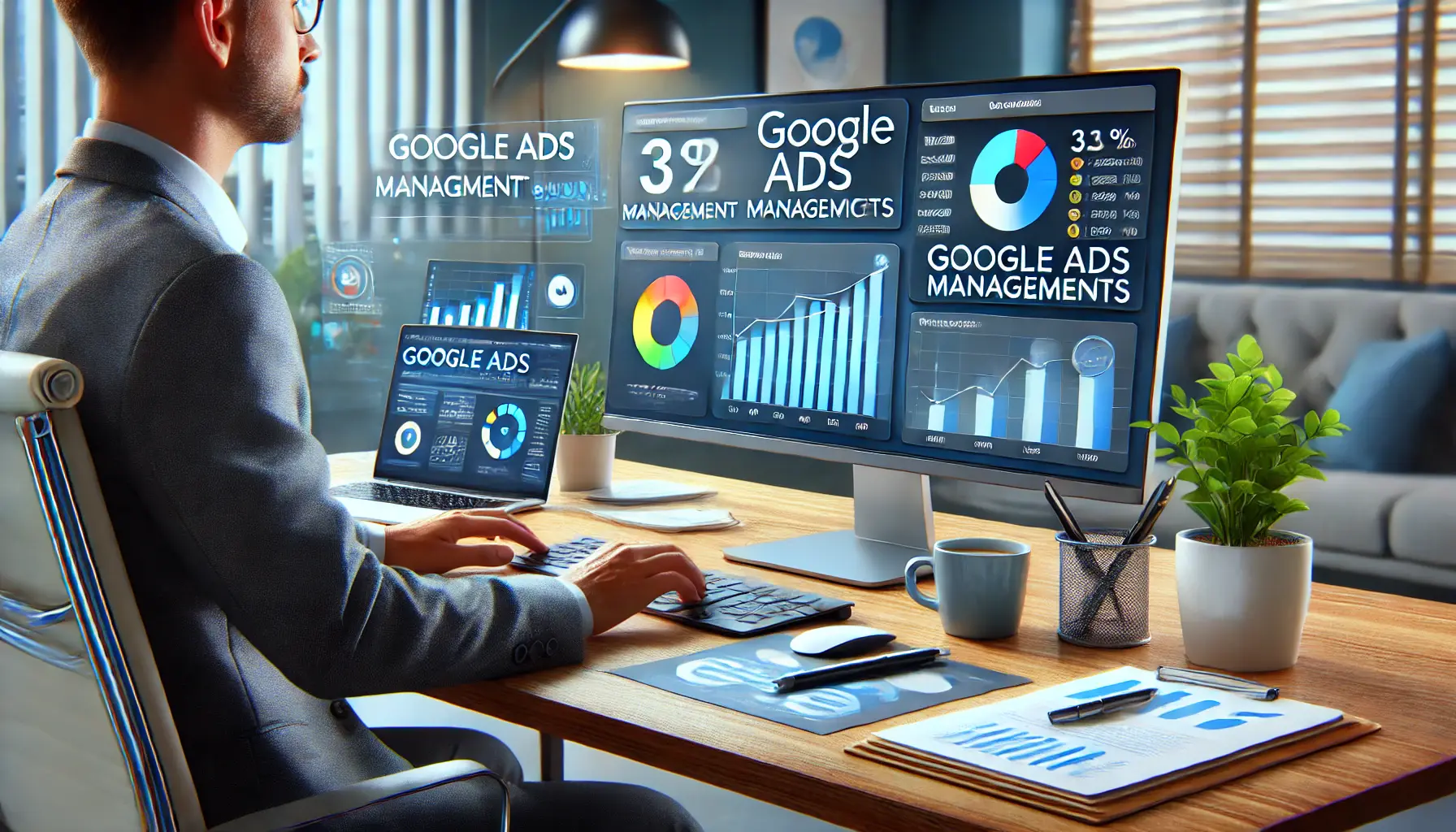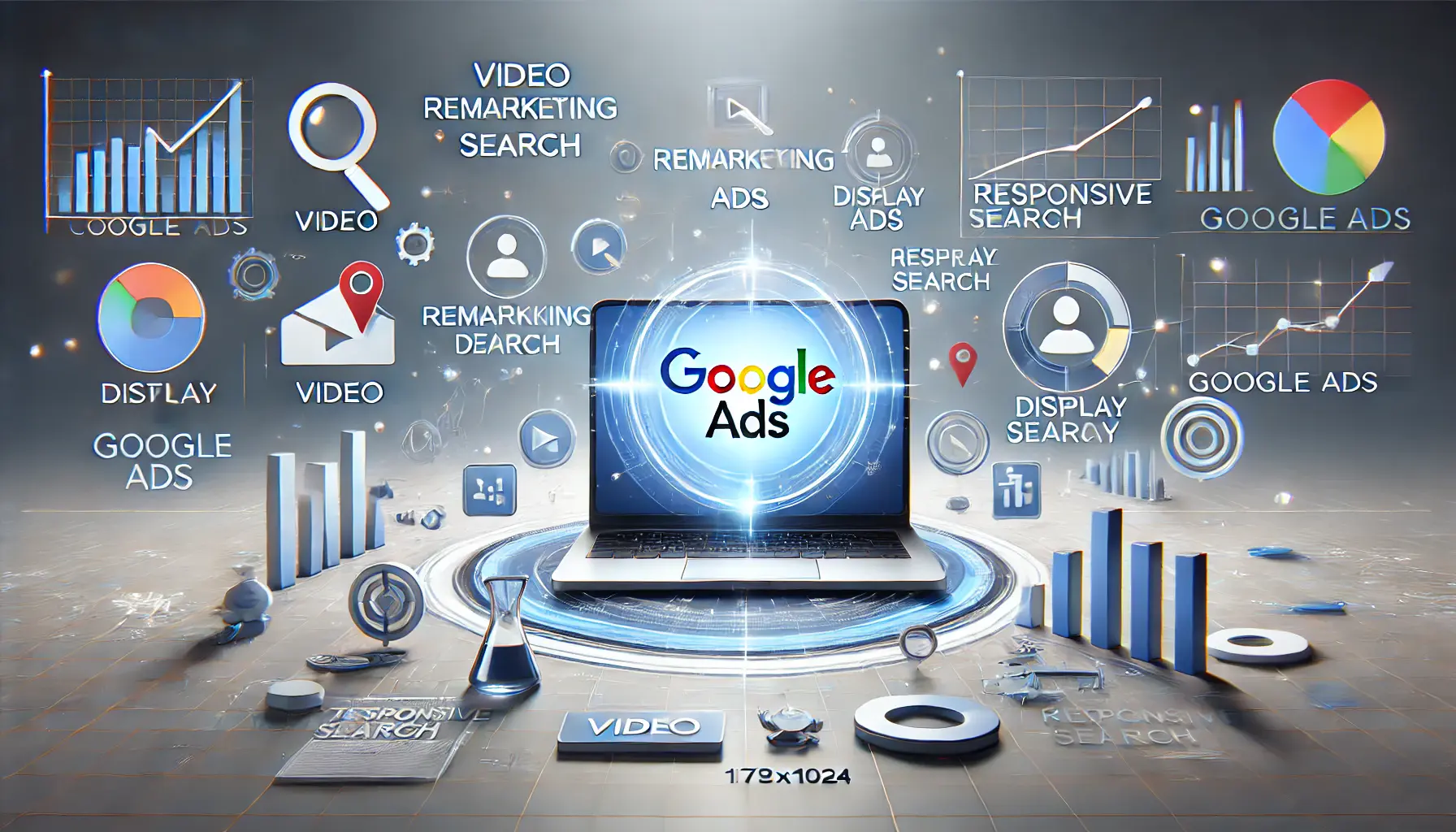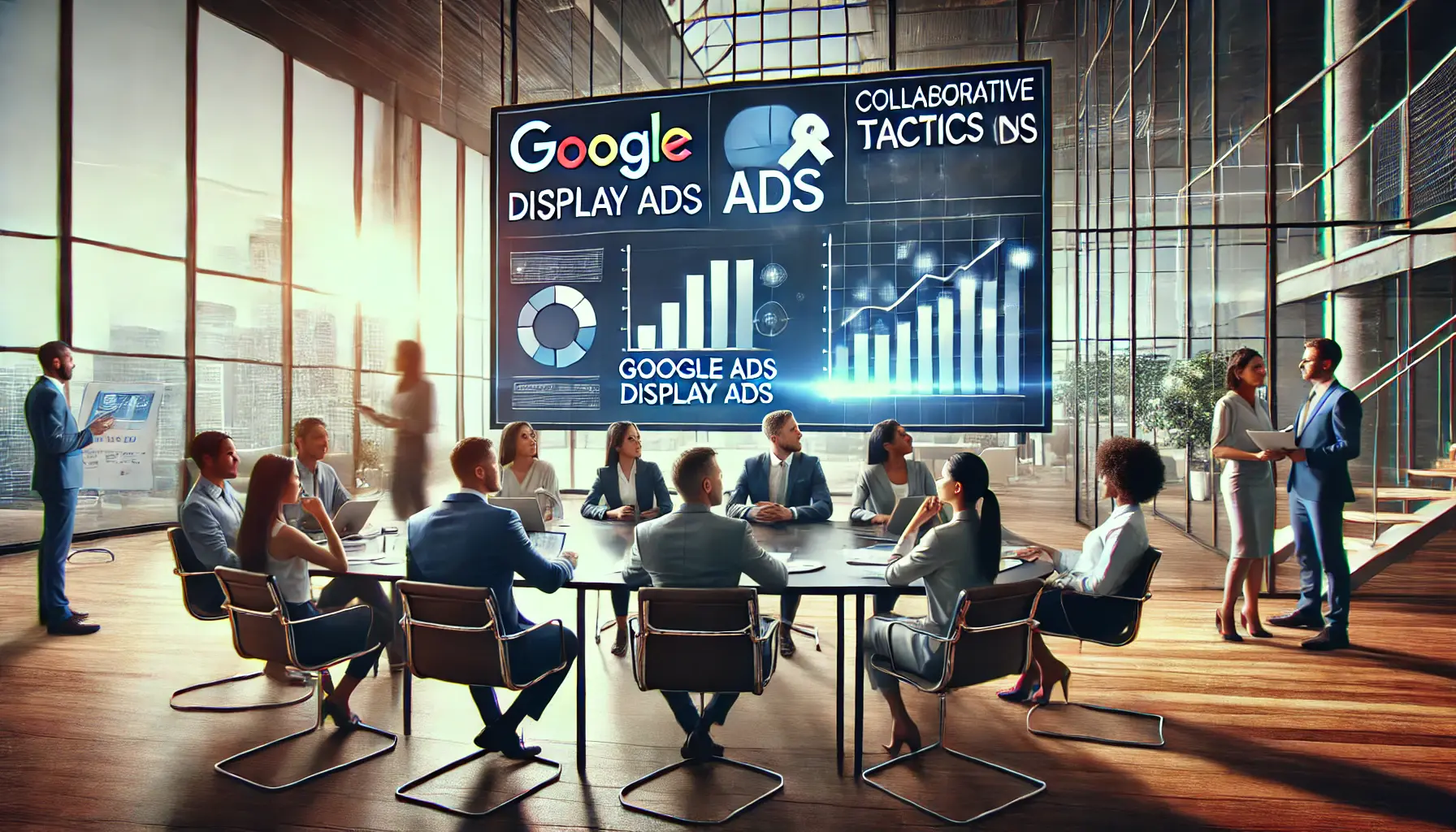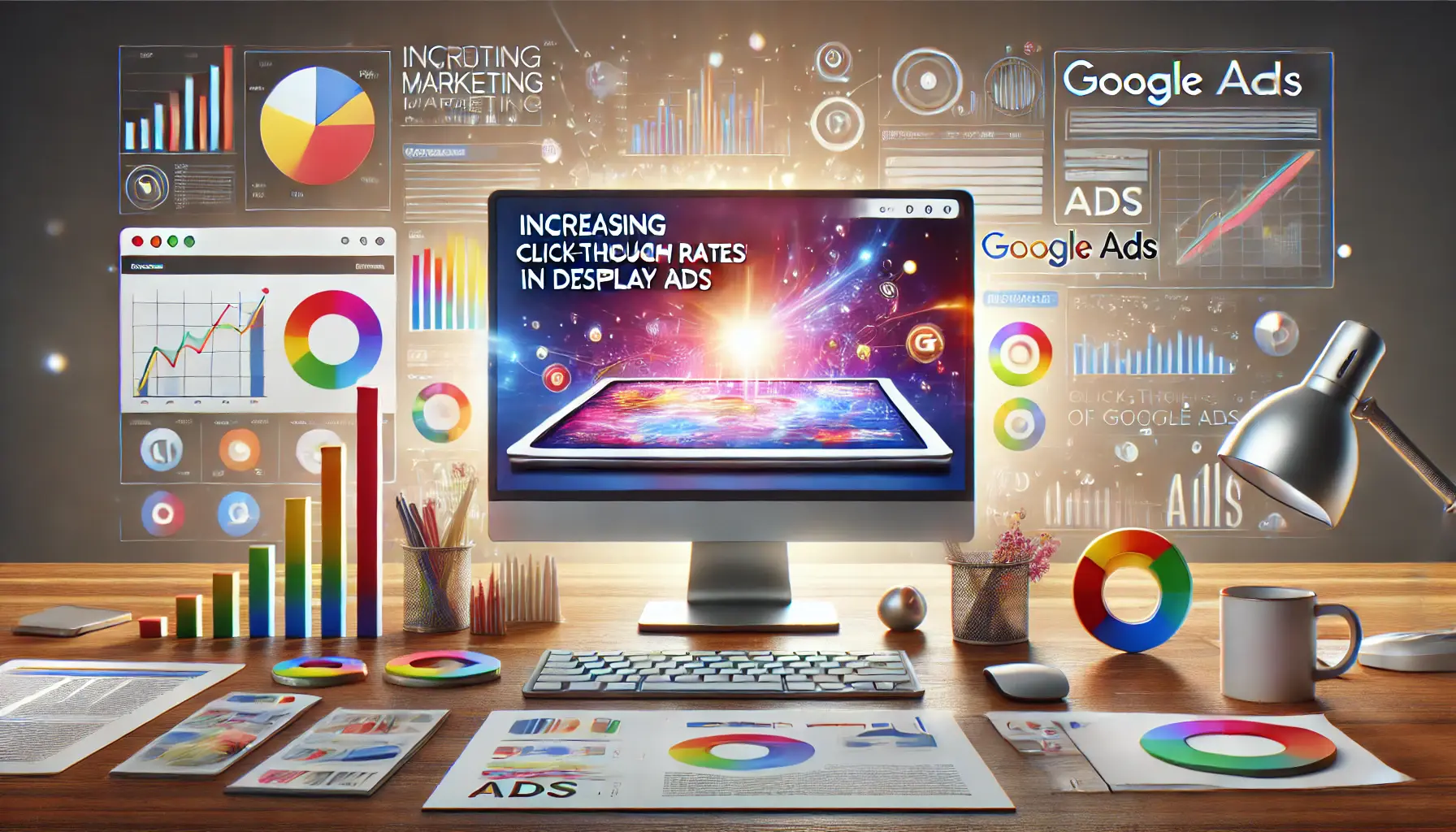Mastering ad positioning in Google Ads today is the difference between a successful campaign and a budget wasted on ineffective placements.
If you have ever wondered why some ads appear at the top while others get buried down the page, the reason lies in understanding how Google Ads determines ad positioning, which holds the key to vastly improving the performance of your campaign.
In this article, we dive into ad positioning tactics and explore what works best to improve your ad visibility and ROI.
- Understanding Ad Positioning in Google Ads
- Key Metrics to Influence Google Ads Positioning
- Advanced Ad Positioning Strategies for Higher ROI
- How to Effectively Track and Analyze Your Ad Positioning
- Best Practices for Keeping Your Ad Positions in the Optimal Range within Google Ads
- Conclusion: Mastering Ad Positioning for Google Ads Success
- Frequently Asked Questions About Ad Positioning in Google Ads
Understanding Ad Positioning in Google Ads
Ad positioning refers to the exact position at which your ad will show up on the search engine results page (SERPSearch Engine Results Page, the page displayed by search engines in response to a query.) when users are looking for a keyword related to your campaign.
The higher the position, the more visible your ad will be, giving you a better chance of attracting clicks and conversions.
But what determines the placement of your ad?
Ad positioning within Google Ads is not random.
Instead, it’s determined through various factors, including your bid, the quality of your ad, and its relevance to the user’s query.
Let’s break down these core concepts of ad positioning so you can start optimizing your campaigns.

Understanding Ad Positioning in Google Ads
What is Ad Positioning?
Ad positioning in PPCPay-Per-Click, a digital advertising model where advertisers pay each time a user clicks on their ad. refers to the ranking of your ad against others when a search query occurs.
The top positions on the search results page receive the highest traffic, which makes securing a good position crucial if you want to capture users’ attention.
It’s usually indicated by a number, with ‘Position 1’ being the highest-ranking ad.
Each time a user enters a query, your ad competes in an auction with other ads bidding to appear.
Your performance in this auction is based on various criteria, which we will explore further as we continue through this article.
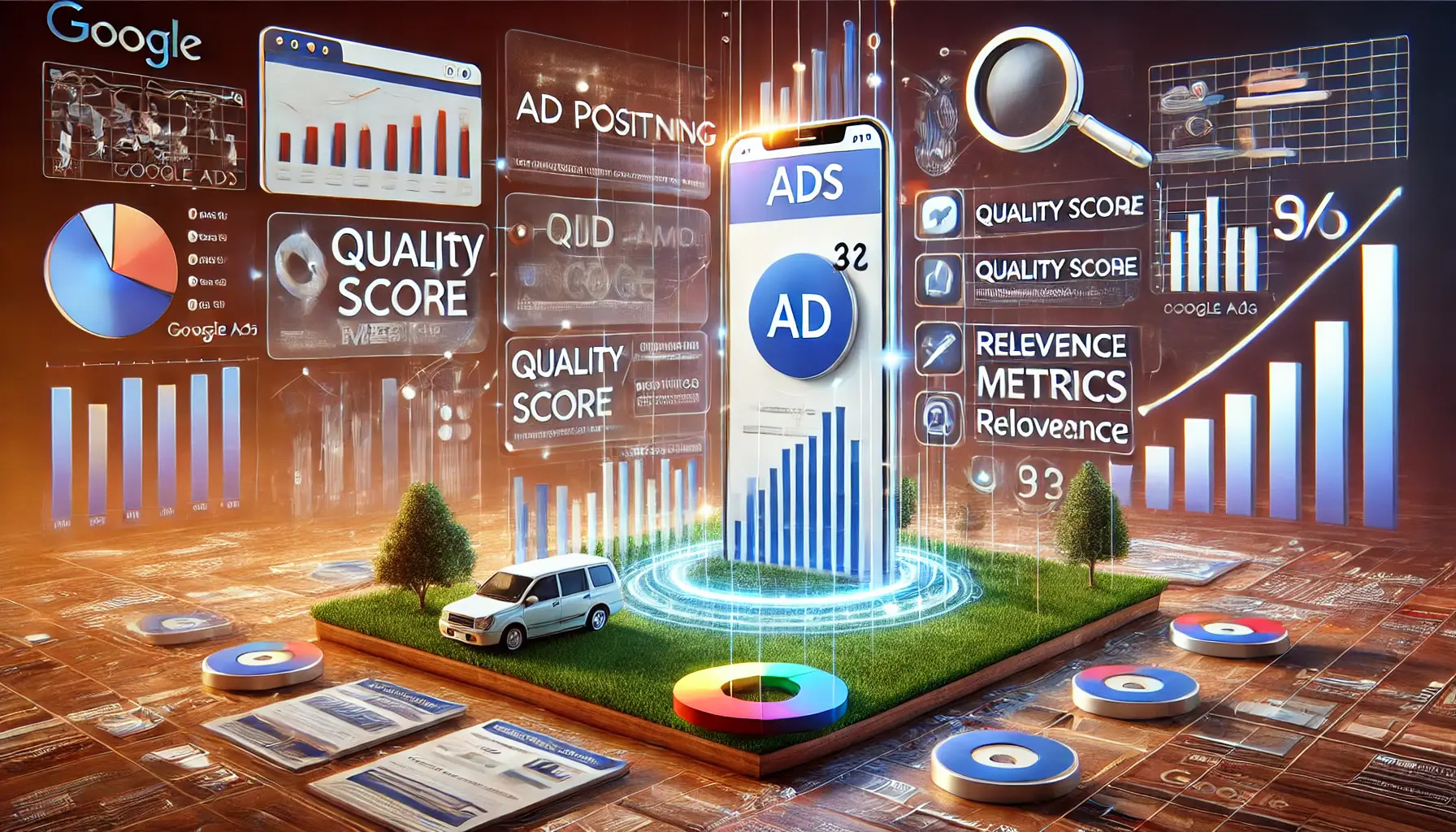
Understanding the Factors Affecting Ad Positioning in Google Ads
Factors Affecting Ad Positioning
Several factors determine the position of your advertisement, including:
- Ad Rank: This is a combination of your bid amount and the quality of your ad. A higher ad rank increases your chances of securing a top spot on the search results page. Key elements considered by search engines include the actual cost of the bid, the keyword’s commercial value, the user experience conveyed by the landing page, and the ad’s past performance, such as click-through rates.
- Quality Score: A higher Quality Score, which measures the relevance and quality of your ad, can lead to better ad positioning, even if your bid is lower than a competitor’s.
- Bidding Strategy: Your bidding strategy plays a crucial role in how much you’re willing to pay per click and how aggressively your ad competes in auctions. Ads that are highly relevant to the search query will rank higher.

The Impact of Ad Positioning on Campaign Performance
Why Ad Positioning Matters to Campaign Performance
Ad positioning is important because it directly affects your ad’s visibility.
Ads appearing in the top positions generally have a significantly higher click-through rate (CTRClick-Through Rate, a metric that measures the ratio of users who click on an ad to the number of total users who viewed it.) than ads placed lower on the page.
Greater visibility leads to increased traffic, higher conversions, and ultimately better ROI.
If your ad isn’t visible or is placed too low on the page, you may be missing out on potential customers who won’t scroll far enough to see your offer.
Ensuring your ad achieves a strong position is crucial for maximizing your performance on Google Ads.
By focusing on the improvements discussed here, you can enhance your ad rank and gain an advantage over competitors.
Ad positioning is determined by a combination of bid, ad quality, and relevance. Mastering this balance is key to improving campaign performance.
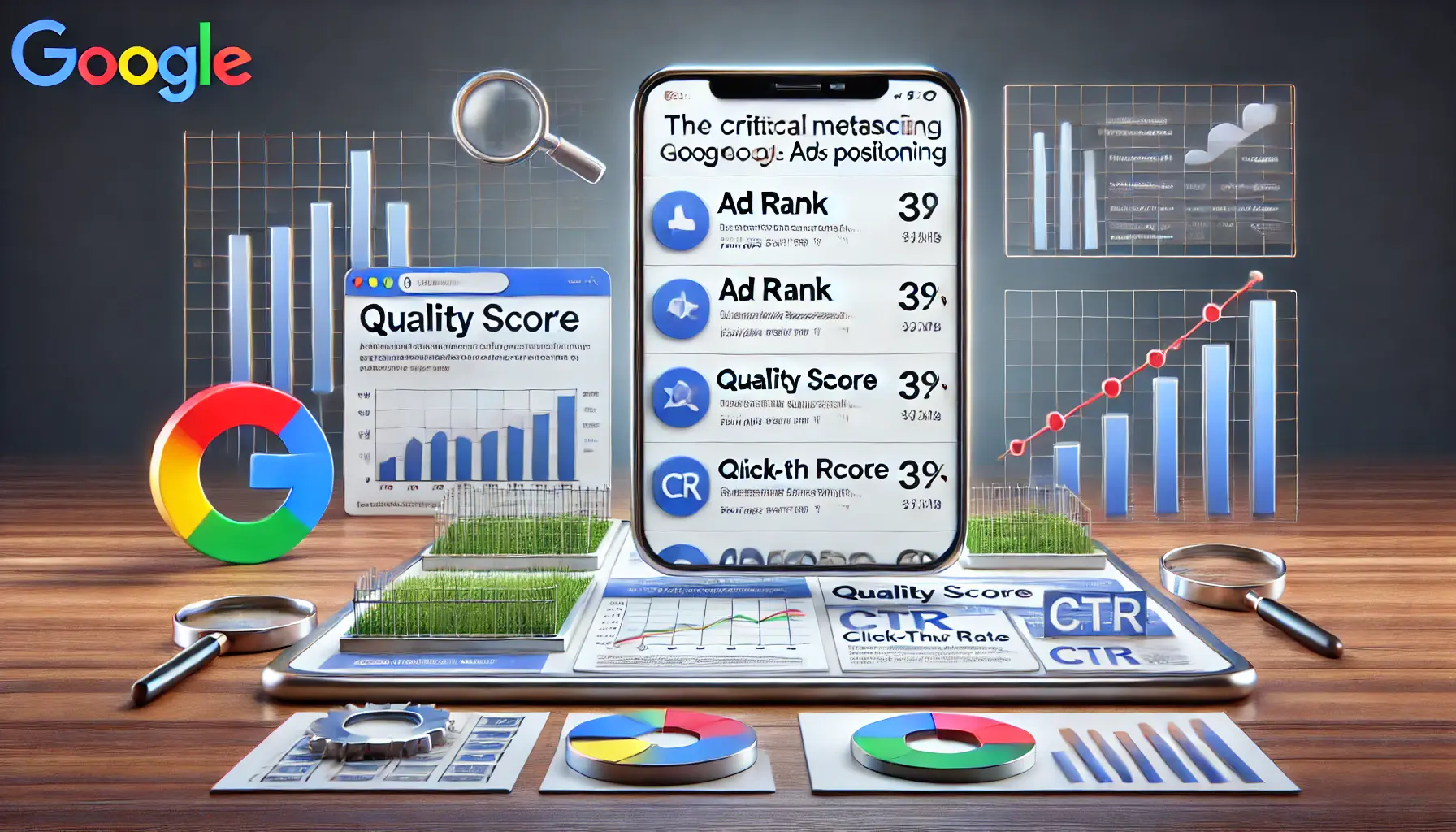
Understanding Key Metrics for Google Ads Positioning
Key Metrics to Influence Google Ads Positioning
To achieve a high ad position in Google Ads, you need to know what metrics drive your ad’s positioning on the Search Engine Results Page (SERP).
Google Ads considers a combination of metrics that influence where your ad will rank.
Learn these metrics and optimize your campaigns for better visibility and ROI.
Let’s explore the key factors that directly affect your ad positioning.

The Impact of Ad Rank on Google Ads Performance
Ad Rank and Its Impact
Your ad rank is one of the most important metrics in determining your ad’s position.
Google calculates your ad rank by multiplying your maximum bid by your Quality Score.
A higher ad rank means a better chance of your ad appearing at the top of the page.
It’s not all about how much you want to pay; the quality and relevance of your ad also play a very important role.
To improve your ad rank, consider the following:
- Increase Your Bid: If your bid is low, your ad may not appear in top positions. Increasing your bid amount can help raise your position.
- Improve Your Quality Score: By increasing the relevance of your ad, keywords, and landing page, you can boost your Quality Score, which may improve your ad rank even if your bid is not as high.
- Ad Extensions: Adding extensions to your ad, like site links or callouts, can improve your ad’s overall performance, which will enhance your ad rank.

Understanding Quality Score and Its Importance in Google Ads
Quality Score: What It Means and How to Improve It
A good Quality Score reduces the cost per click (CPC) and also improves your ad rank in the SERP.
Google considers the following elements when calculating your Quality Score:
- Expected Click-Through Rate (CTR): This metric reflects how likely users are to click on your ad. A higher expected CTR correlates with a better Quality Score.
- Ad Relevance: Google assesses how relevant your ad is to the intent behind the user’s search query. Ads that closely match the search intent will have a higher rating.
- Landing Page Experience: A landing page that offers value, fast loading times, and a good user experience will positively influence your Quality Score.
By paying constant attention to these elements and making regular adjustments, you can maintain a high Quality Score over time, resulting in better ad positioning.
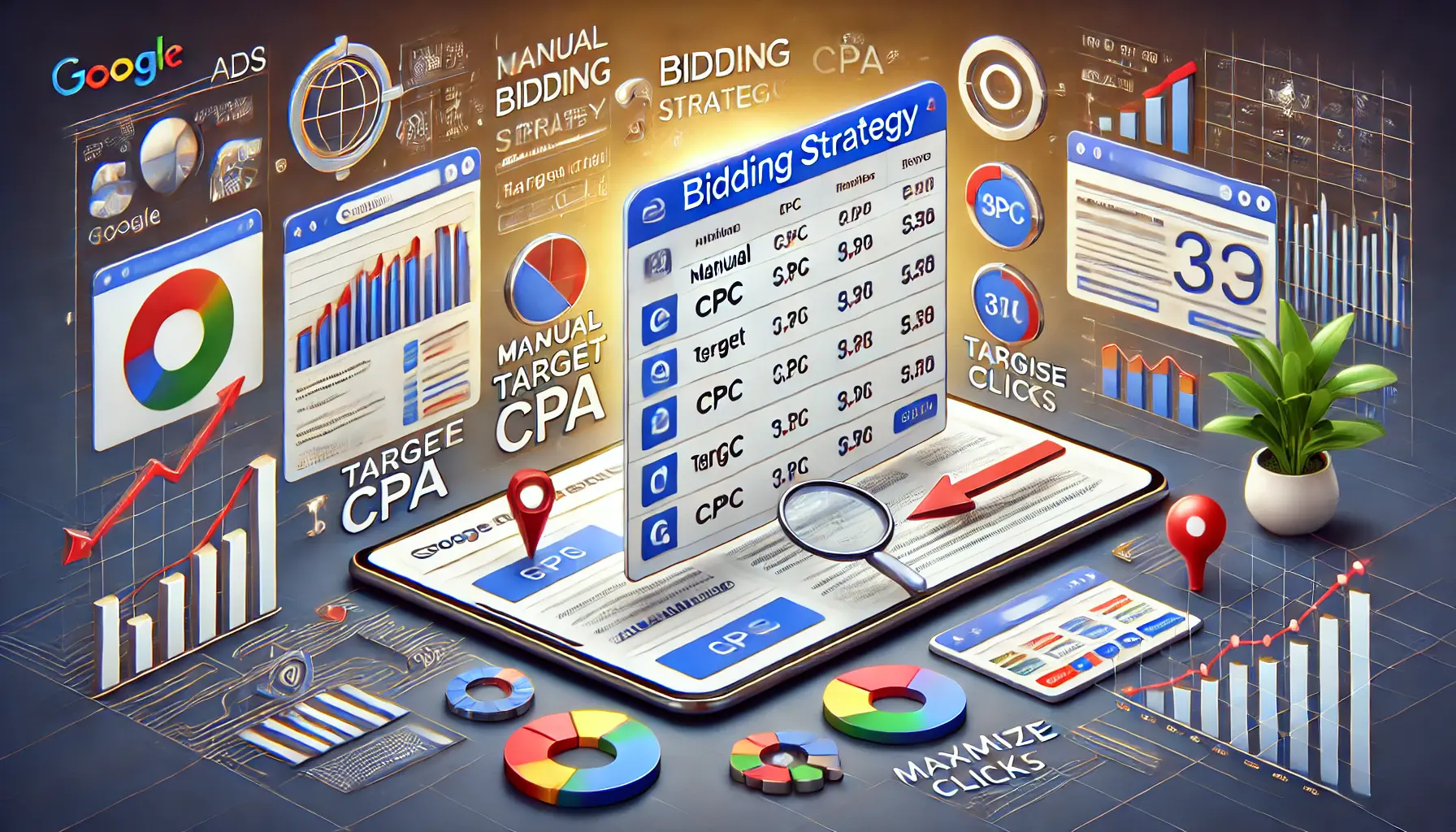
Understanding the Impact of Bidding Strategy on Ad Positioning
The Role of Bidding Strategy in Ad Positioning
Your bidding strategy determines how aggressively you compete for ad placements.
Choosing the right bidding strategy helps balance cost and performance efficiently.
Google Ads offers several bidding strategies, including:
- Manual CPC Bidding: You set the maximum cost per click, giving you full control over each ad group or keyword. However, this approach requires constant monitoring and updates.
- Target CPA (Cost Per Acquisition): Google automatically adjusts your bids to achieve a specific cost per acquisition, making this ideal for conversion-focused campaigns.
- Maximize Clicks: Google sets your bids to get as many clicks as possible within your budget, making this approach suitable when traffic is the primary goal.
- Target ROAS (Return on Ad Spend): Google modifies bids to achieve a targeted return on ad spend, focusing on maximizing the revenue earned for every dollar spent on ads.
For example, if your goal is to drive conversions, a Target CPACost Per Acquisition, the cost of acquiring a customer through an advertisement. strategy might be more fitting than a Maximize Clicks approach.
Regularly reviewing your bidding strategy ensures it remains aligned with your objectives, giving your ad the best possible positioning.
Focus on metrics like Ad Rank, Quality Score, and CTR to improve your ad’s positioning and overall campaign performance.
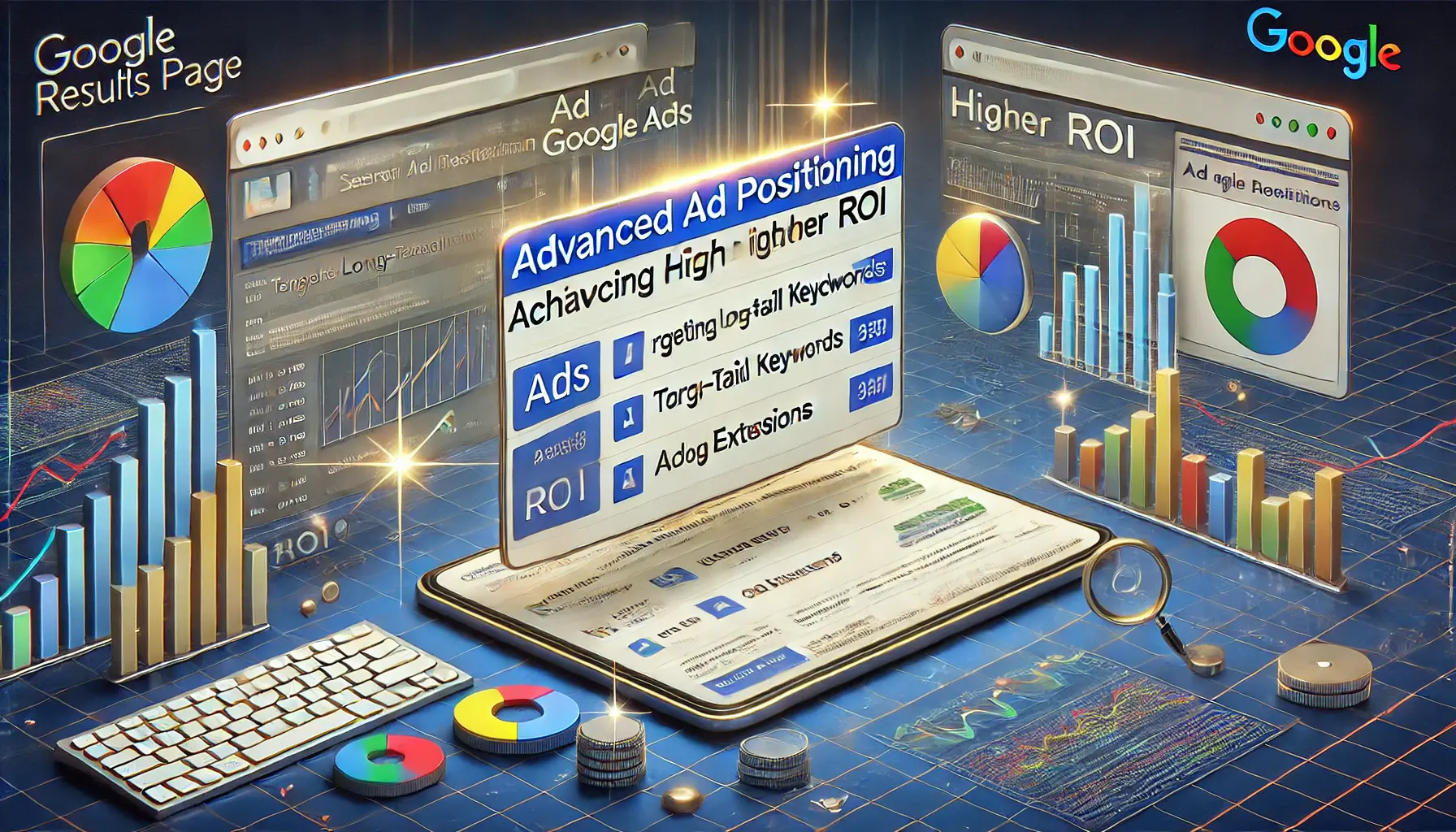
Maximizing ROI with Advanced Ad Positioning Strategies
Advanced Ad Positioning Strategies for Higher ROI
Improving your Google Ads positioning requires more than just increasing your bid or improving your Quality Score.
To achieve consistent success and higher ROI, you need to implement advanced strategies that focus on optimization across various aspects of your campaigns.
These strategies will help you outsmart competitors while maximizing the visibility and performance of your ads.
Let’s explore the top techniques to boost your ad positioning and increase your return on investment.

Strategies for Optimizing Bids on Competitive Keywords
Optimizing Bids for Competitive Keywords
Targeting the right keywords is one of the most critical aspects of improving your ad positioning.
However, competitive keywords often come with higher costs.
To ensure you stay ahead of the competition, it’s essential to optimize your bidding strategy for these high-value keywords.
Use Google’s bid simulator to find the sweet spot between cost and performance while testing out bidding strategies.
To further optimize your bids for competitive keywords, consider the following:
- Bid Adjustments: Increase bids for top-performing keywords or those that have proven to be highly converting.
- Long-Tail Keywords: Target long-tail, less competitive keywords that are still closely related to your business. These will help you get better positioning without necessarily increasing your ad cost.
- Automated Bidding Tools: Use Google’s automated bidding strategies, including Target CPA or Target ROAS, to dynamically adjust bids based on real-time data.
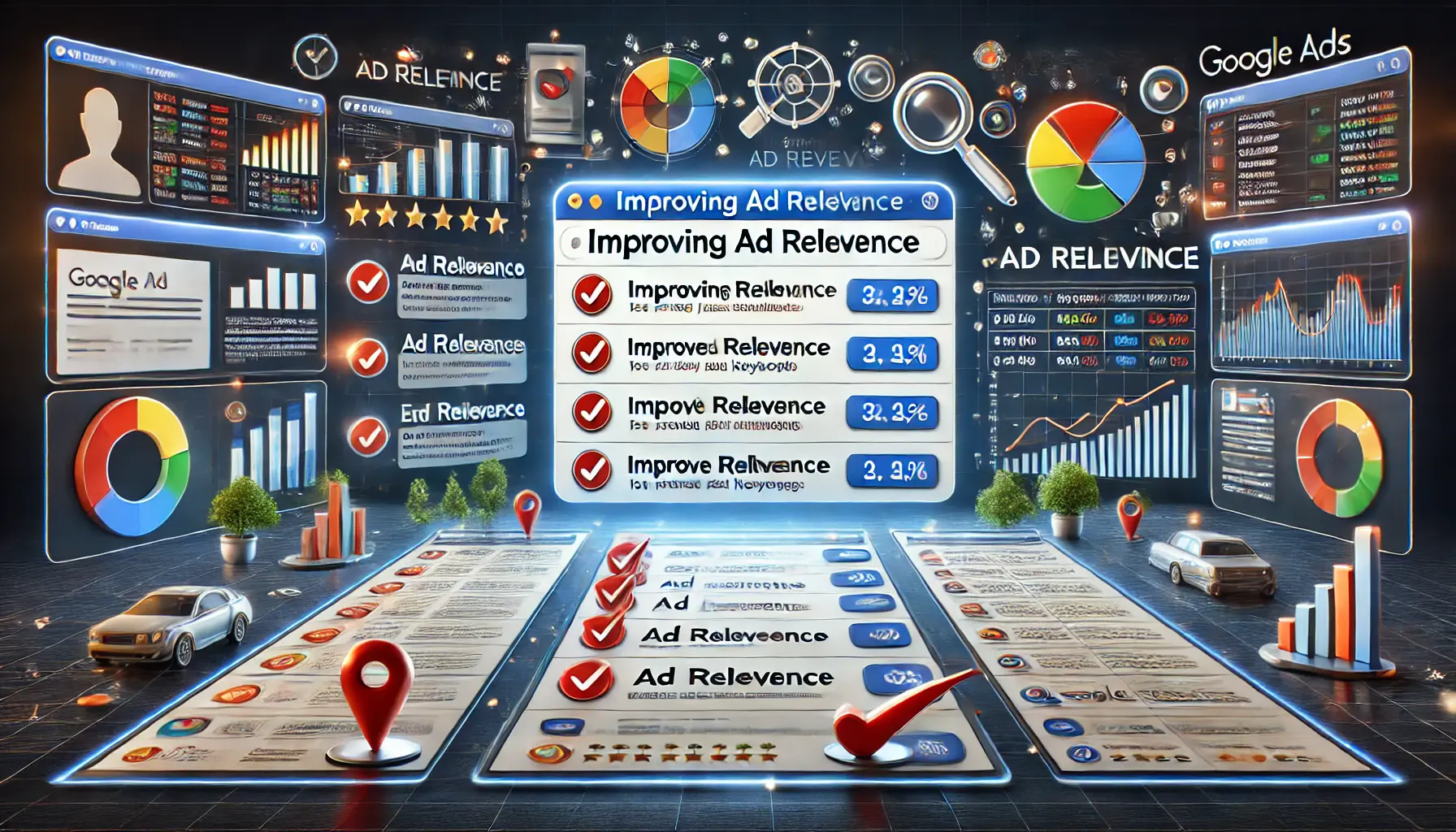
Enhancing Ad Relevance for Better Positioning
Improving Ad Relevance to Enhance Positioning
To improve ad relevance, refine your ad copy so that it closely matches the intent behind the keywords you are targeting.
Relevant ad copy increases click-through rates (CTR), boosts your Quality Score, and ultimately improves your ad positioning.
Here are some tips to make your ads more relevant:
- Dynamic Keyword Insertion (DKI): DKI allows you to automatically insert the user’s search query into your ad copy, making it more relevant to their search.
- Align Ad Copy with User Intent: Create ad copy that directly addresses the needs or pain points of your target audience. This will increase engagement and improve your ad’s positioning.
- Test Different Ad Variations: Regularly test and update different ad variations to see which copy resonates best with your audience and drives higher engagement.

Strategies for Targeting Audience Segments in Google Ads
Targeting Audience Segments for Better Placement
Focusing on the most relevant audience segments is a powerful way to increase engagement and improve ad performance.
Google Ads provides audience targeting options, such as in-market audiencesA type of audience targeting based on users actively searching for products or services., affinity audiencesAudience segments in Google Ads based on users’ long-term interests or lifestyle choices., and remarketing lists, to help you show your ads to users who are more likely to convert.
To effectively target audience segments, consider the following:
- Remarketing: Serve your ads to users who have previously visited your website, increasing the chances of converting them into customers.
- In-Market Audiences: Target users who are actively searching for products or services similar to yours, making your ad more relevant to their current needs.
- Affinity Audiences: Target users based on their broader interests and lifestyles to ensure your ads reach a more relevant audience.
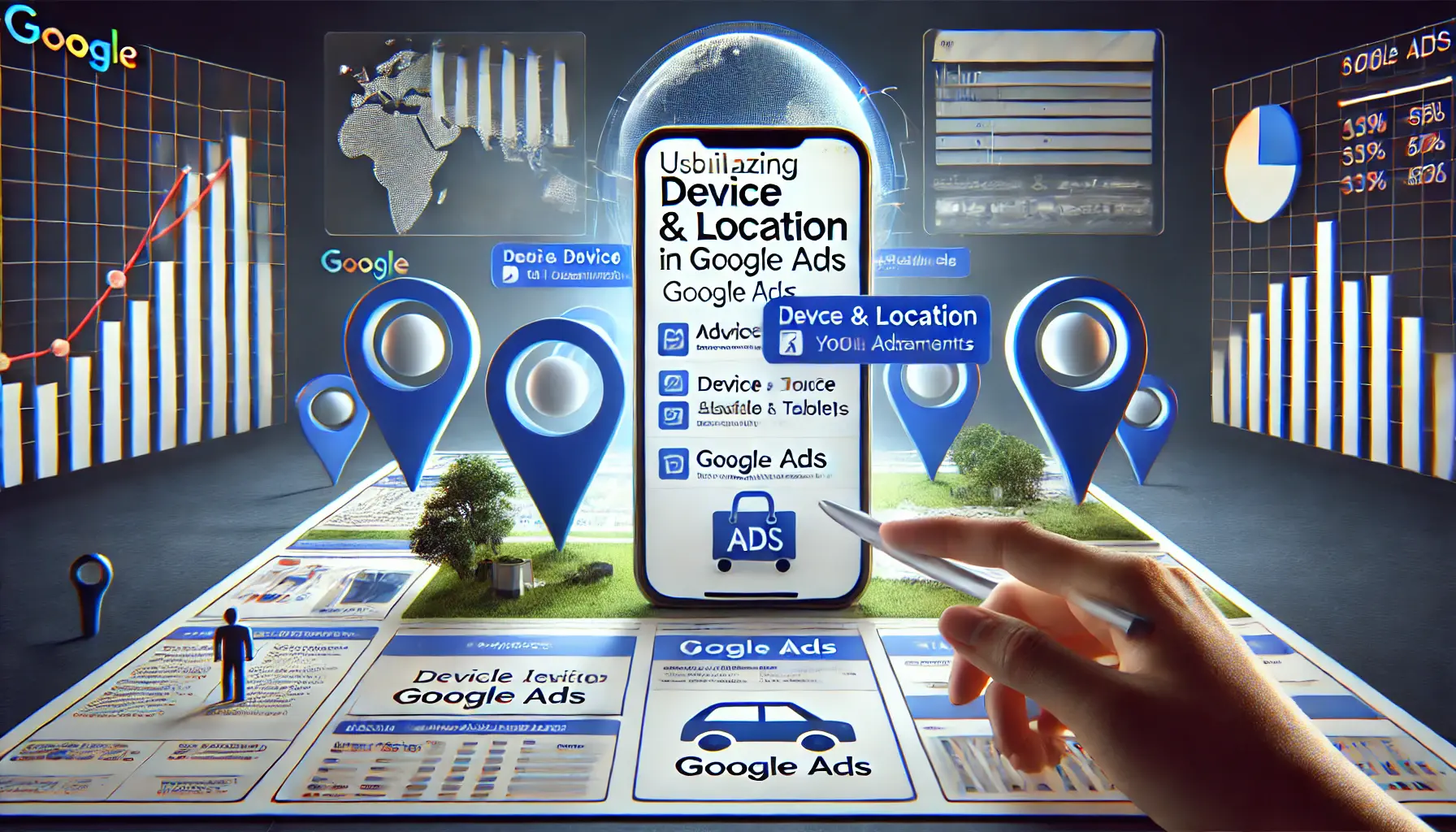
Optimizing Ads with Device and Location Adjustments
Utilizing Device and Location Adjustments
Optimizing your ad positioning for different devices and locations is crucial for reaching the maximum number of potential viewers and boosting your ROI.
In Google Ads, you can adjust your bids based on the device type (desktop, mobile, or tablet) and user location.
Tailoring your bidding strategy to specific behavior patterns across devices and locations will enhance your ad’s effectiveness.
For maximizing device and location adjustments, consider the following:
- Device Bid Adjustments: Increase bids for devices that show higher conversion rates. For example, prioritize mobile bids if mobile users are converting more frequently.
- Location-Based Bidding: Increase bids for locations where your products or services are in higher demand to ensure that your ads reach the right audience.
- Dayparting: Adjust bids based on the time of day or day of the week when your audience is most active, ensuring your ads appear during peak hours.
By using these advanced strategies, you can significantly improve your ad positioning and achieve higher ROI in your Google Ads campaigns.
Advanced strategies such as optimizing bids for competitive keywords and audience segmentation can help you boost ad positioning and ROI.

Tracking and Analyzing Ad Positioning in Google Ads
How to Effectively Track and Analyze Your Ad Positioning
Monitoring and analyzing ad positioning are crucial for ensuring your Google Ads campaigns perform optimally.
Tracking key metrics and understanding how the positioning of your ads impacts performance will help you make data-driven adjustments to improve visibility, lower costs, and increase ROI.
This section highlights the best tools and techniques to track and analyze your ad positioning effectively.

Essential Tools for Monitoring Google Ads Positioning
Tools to Monitor Google Ads Positioning
Here are some of the top tools for monitoring ad positioning:
- Google Ads Position Metric: Google Ads provides extensive metrics on average position and impression share to help you understand where your ad is appearing on the SERP. The metrics ‘Search Top IS’ and ‘Search Absolute Top IS’ show how often your ads appear at the top of the page.
- Google Analytics: You can link your Google Ads account with Google Analytics to understand more about user behavior and performance metrics related to your ad campaigns. This offers insights into how ad positioning impacts user engagement on your website.
- SEMrush or Ahrefs: These SEO tools provide valuable data about competitor ad positioning, including how your ads rank versus others in your industry. They also offer features for monitoring keyword rankings and ad copy performance.

Understanding Competitors’ Ad Positioning
Analyzing Competitors’ Ad Positioning
Keeping an eye on your competitors’ ad positioning can offer insights into how you can adjust your bidding and optimization strategies.
Knowing where your competitors’ ads are positioned in relation to yours can help you identify gaps and opportunities in the market.
Tools such as SpyFu or SEMrush provide great data on competitor ads, including the keywords they bid on and how their ad copy performs.
Things to consider when analyzing competitor positioning include:
- Keywords to Watch: Identify the keywords your competitors are bidding on. Are they outranking you? Use this information to optimize your strategies in relation to bids.
- Ad Copy Monitoring: Assess how your competitors create their ad copy. If their ad copy continues to outrank yours, it may be time to test new variations of your ads.
- Benchmarking: Leverage competitor positioning data to set performance benchmarks for your own campaigns to stay competitive within your industry.

Optimizing Campaigns with Position Metrics
Using Position Metrics to Optimize Campaigns
By regularly analyzing positioning metrics, you can make decisions about budget allocations, keyword performance, and bid adjustments.
Metrics such as ‘Impression Share,’ ‘Search Top Impression Share,’ and ‘Search Lost IS (Rank)’ help indicate how often your ads are appearing in prime positions and where improvements can be made.
For optimizing based on positioning metrics, consider the following:
- Analyze Impression Share: This metric shows how many impressions your ads are getting compared to the total available impressions. A low impression share may indicate that your budget or bid is too low.
- Position-Based Bid Adjustment: If your ad consistently appears lower in position, it might be time to increase your bids or improve your Quality Score to move up the SERP.
- Watch Trends Over Time: Keep an eye on your ad position over time to spot trends. If your position is declining, it could signal increased competition or the need for campaign adjustments.
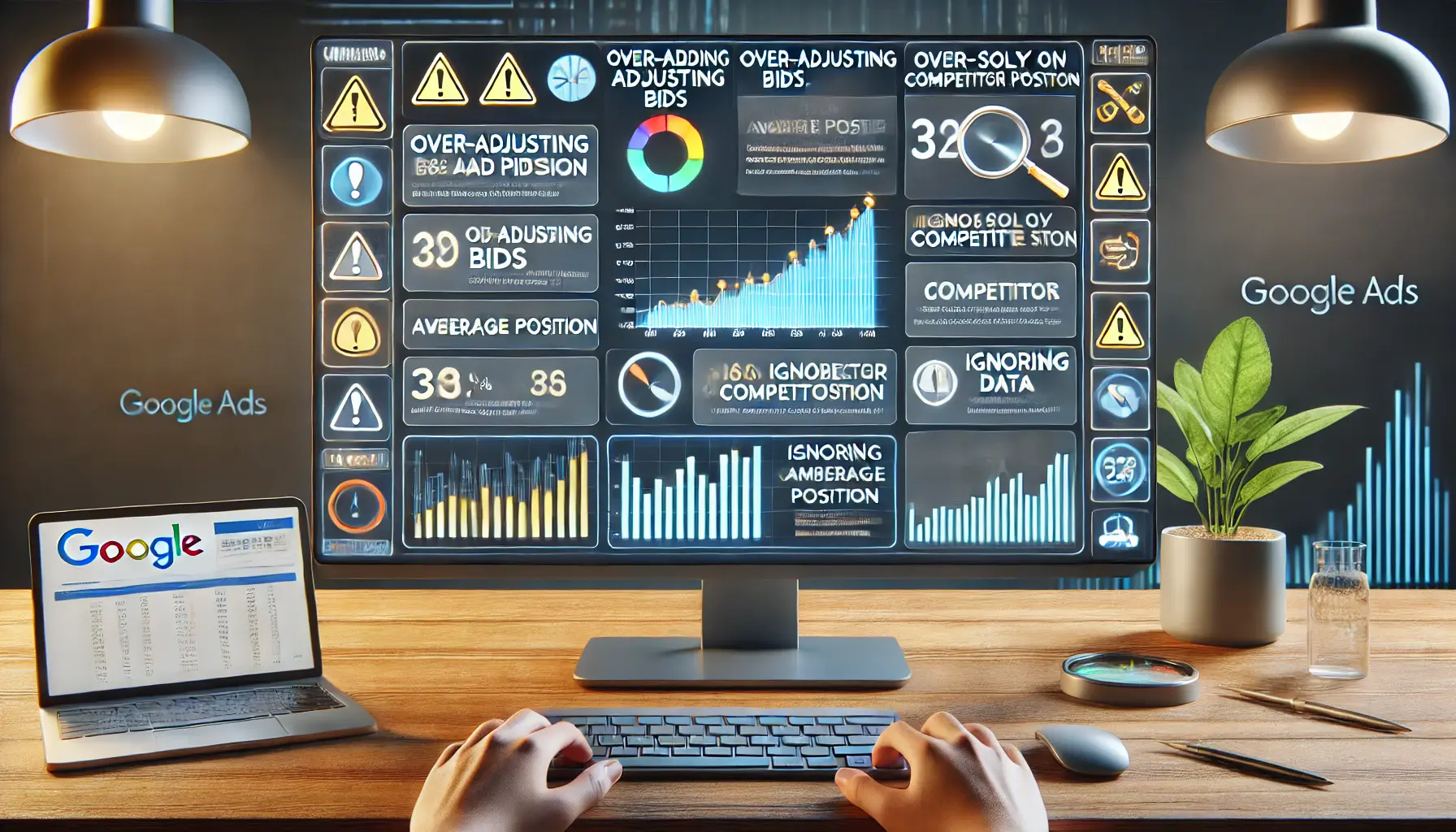
Avoiding Common Mistakes in Ad Position Analysis
Common Mistakes in Ad Position Analysis
While tracking and analyzing ad positioning metrics is essential, there are some common mistakes that advertisers make.
Avoiding these pitfalls ensures you get accurate data and make the right optimizations:
- Focusing Solely on Average Position: The average position metric can be misleading, as it doesn’t always reflect how often your ad appears at the top of the page. Use other metrics like ‘Search Top IS’ to get a complete picture of your ad’s positioning.
- Missing Out on Competitor Data: Failing to monitor competitor ad positioning puts you at a disadvantage. Stay informed about how your competitors are performing to remain competitive.
- Over-Adjusting Based on Position Fluctuations: Ad positions can fluctuate frequently. Avoid making hasty decisions based on short-term changes. Look for long-term trends before making significant adjustments.
By implementing effective tracking and analysis of your ad positioning, you can optimize your Google Ads campaigns for better performance and ensure you get the most value from your advertising budget.
Using tools like Google Ads and SEMrush to track positioning can provide insights into improving your campaign’s performance and visibility.
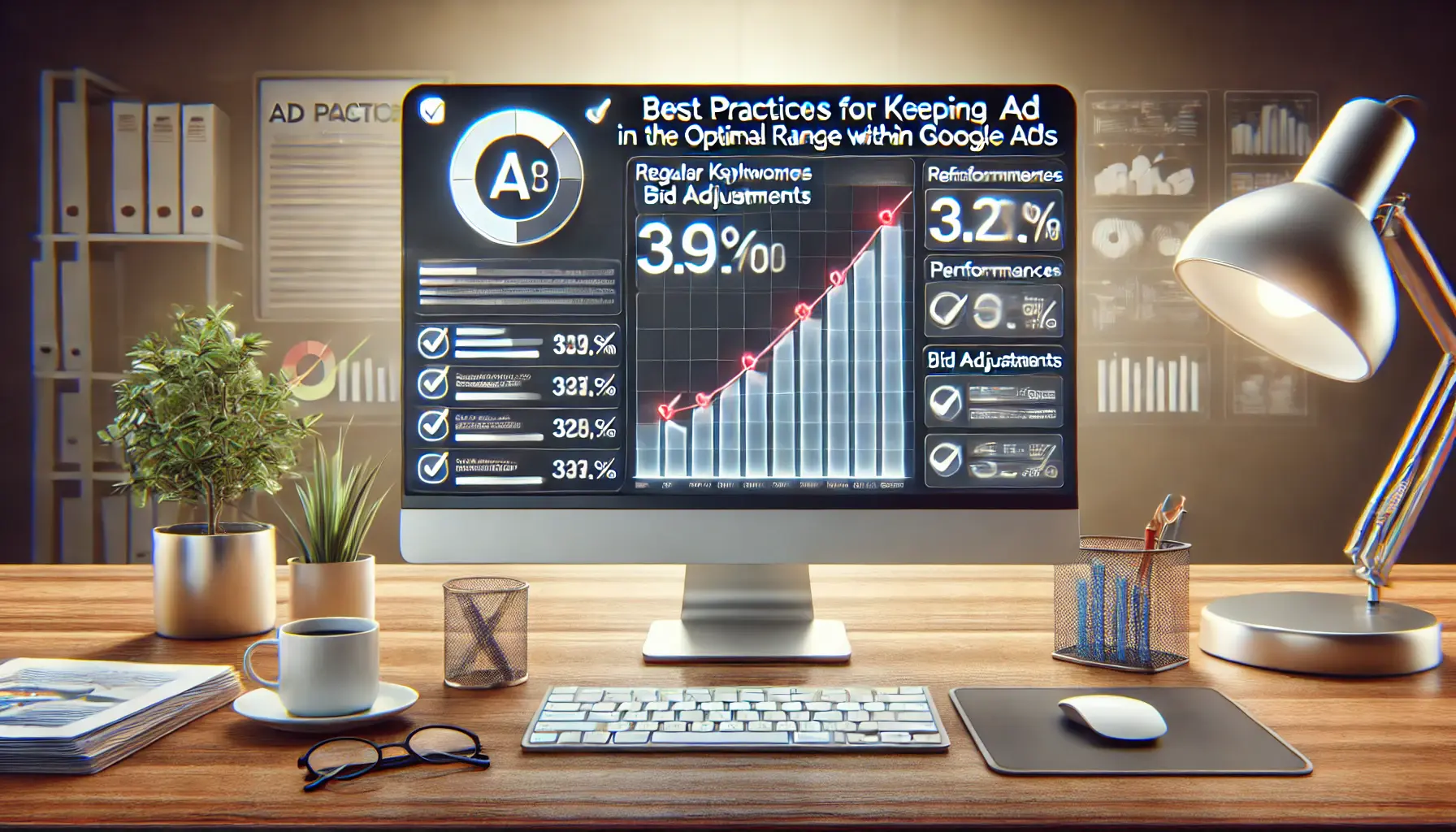
Maintaining Optimal Ad Positions in Google Ads
Best Practices for Keeping Your Ad Positions in the Optimal Range within Google Ads
Maintaining an optimal ad position in Google Ads is a continuous process that requires constant adjustments and optimization.
Changes in competition, budget, or overall campaign performance may cause ad positions to shift out of the optimal range.
To ensure your ads continue to occupy top positions on the search engine results page (SERP), it’s important to follow best practices that involve optimizing various elements of your campaign.
This section discusses how to maintain a competitive edge in ad positioning and maximize visibility using the most effective strategies.
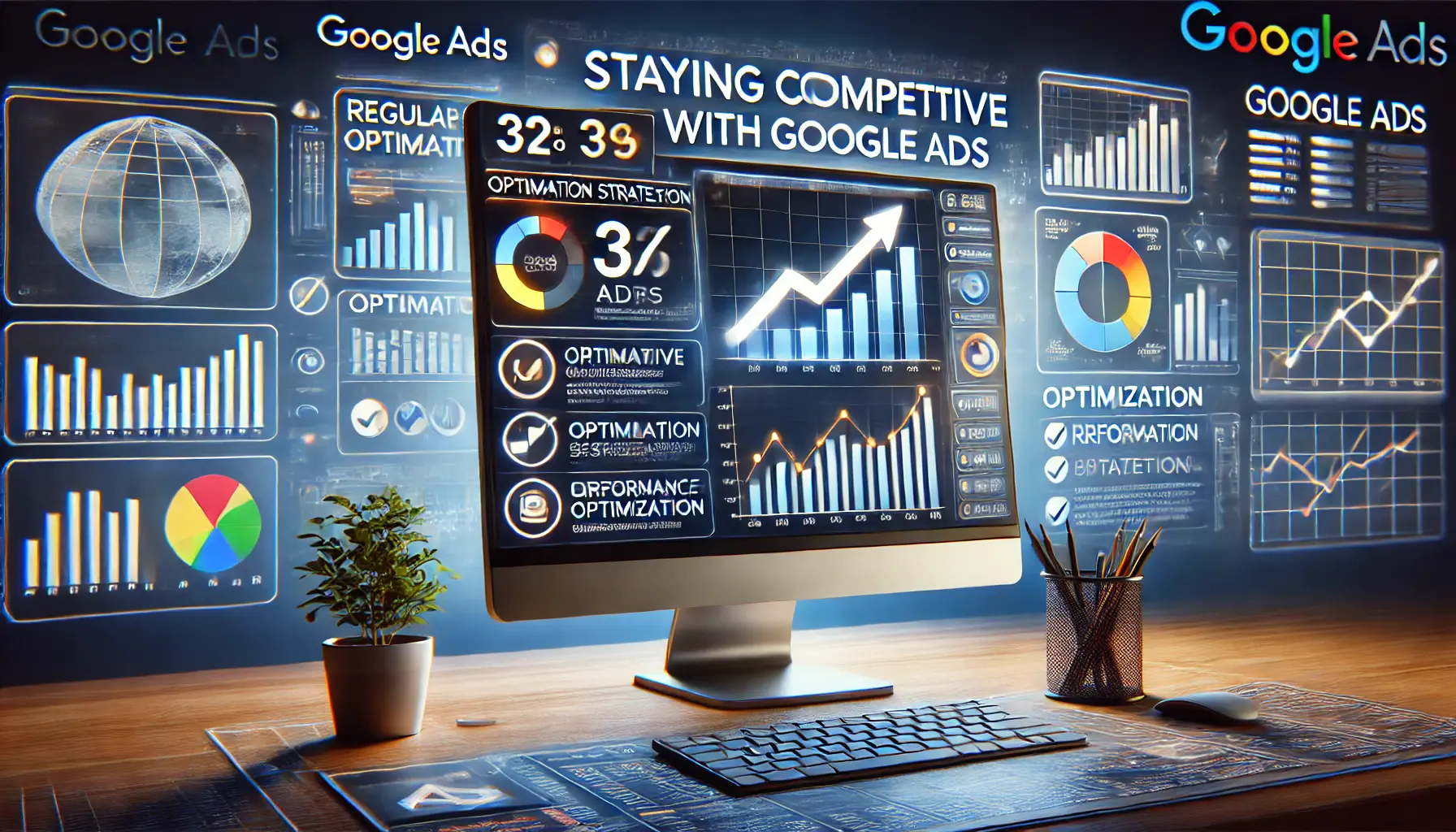
The Importance of Regular Optimization in Google Ads
Staying Competitive with Regular Optimization
Best practices for maintaining a competitive ad position involve regular campaign optimization.
Without regular updates, ads might fall behind in the competition.
Monitoring performance closely and making necessary adjustments will help your ads stay updated with current trends and competitors.
The best practices for ongoing optimization include:
- Update Keywords on a Regular Basis: Continuously research and update your keyword list based on trends and user search behavior. You can improve ad relevance and positioning by adding new, relevant keywords or removing underperforming ones.
- Performance-Based Bid Adjustment: Adjust bids based on keyword performance. Increase bids for high-performing keywords to secure top positions. Conversely, lowering bids on low-performing terms frees up budget for better opportunities.
- Test Ad Variations: Use A/B testing with ad copy and creative variations to determine what resonates best with your target audience. This keeps your ads fresh and engaging, leading to higher click-through rates (CTR) and better ad positions.
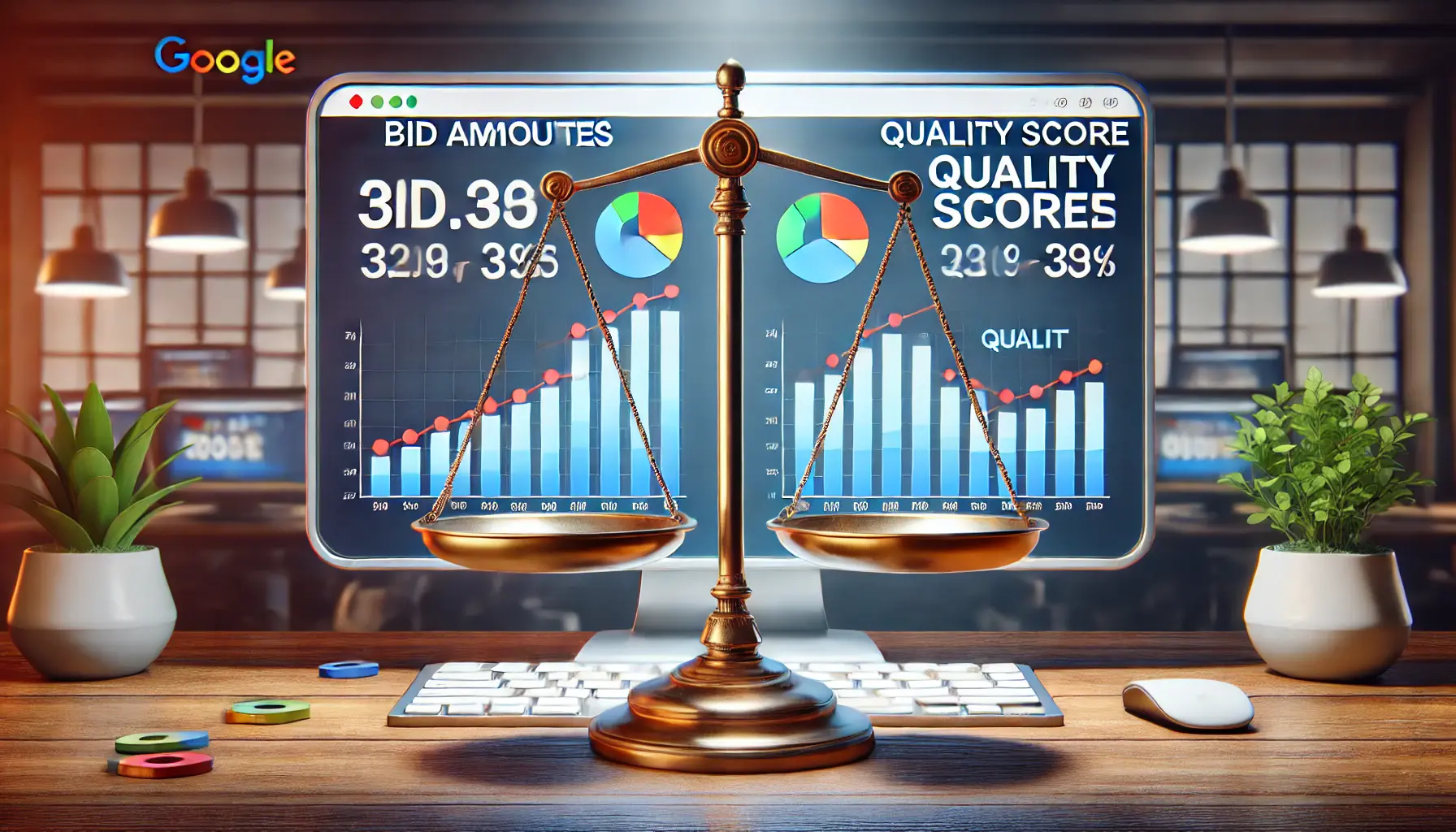
Achieving Balance Between Bid Amounts and Quality Scores
Balancing Bid Amounts and Quality Scores
While bidding is essential for determining ad position, it’s not the only factor.
A high bid won’t guarantee a top spot if your ad’s Quality Score is low.
To maintain the best ad position, you need to balance both bid amounts and Quality Scores.
Here are some tips for balancing bids and Quality Scores:
- Focus on Relevance: Your ad copy, keywords, and landing pages must be relevant to the user’s search intent. The higher the relevance, the better your Quality Score, leading to lower costs and improved positions.
- Bid Strategically: Set competitive bid amounts without overspending. Use automated bidding strategies, such as Target CPA and Maximize Conversions, to manage bid amounts while maintaining a strong ad position.
- Enhance Ad Quality: Create high-quality, compelling ads that attract clicks. The more clicks your ads receive, the higher your CTR, which improves both Quality Score and ad position.
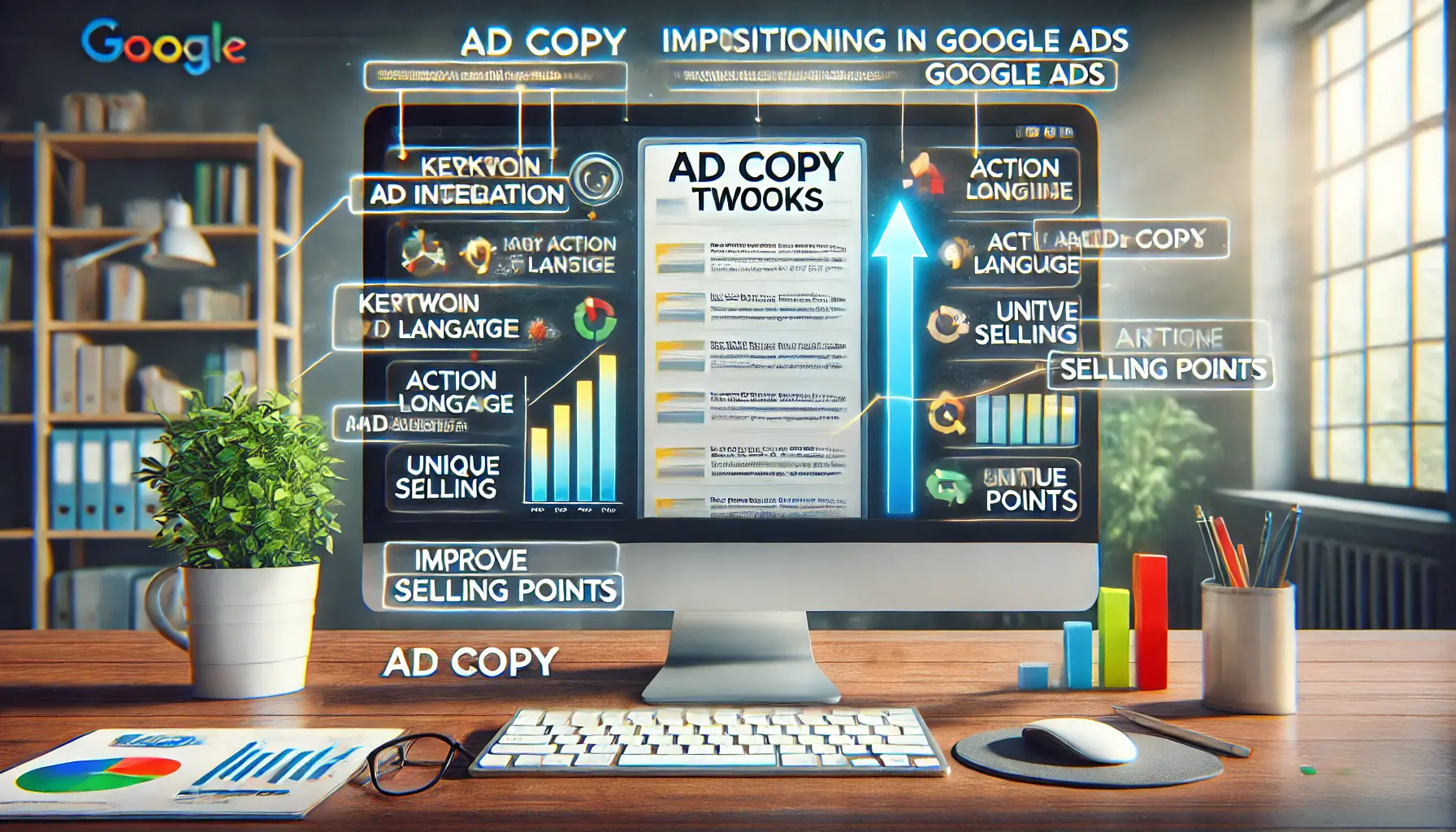
Enhancing Ad Copy for Better Positioning
Ad Copy Tweaks That Improve Positioning
Even small tweaks to your ad copy can significantly impact how users perceive your ad and how well it ranks on the SERP.
Ad copy improvements that can boost positioning include:
- Use Action-Oriented Language: Include strong call-to-action phrases like “Buy Now,” “Learn More,” or “Get a Free Quote” to encourage users to take action and improve engagement and CTR.
- Use Relevant Keywords: Include primary keywords in the ad headline and description to increase relevance. This helps align your ad with user queries and improves your Quality Score.
- Highlight Unique Selling Points (USPs): Showcase what makes your product or service stand out from competitors. This can attract more clicks, improving ad position.

Enhancing Ad Placement with Ad Extensions
Using Ad Extensions for Better Placement
Ad extensions allow you to provide additional information, such as phone numbers, site links, or promotions, which can make your ad more appealing and improve its positioning on the SERP.
Types of ad extensions that enhance ad placement include:
- Call Extensions: Add a phone number to your ad, making it easier for users to contact you directly. This can improve user engagement and increase your Quality Score.
- Site Link Extensions: Include additional links to specific pages on your website, such as product pages or contact information. This increases the likelihood of users clicking on your ad, boosting CTR and ad position.
- Promotion Extensions: Highlight special deals, discounts, or promotions directly within your ad. This attracts more clicks and improves ad positioning.
By following these best practices consistently, you can outperform competitors in Google Ads and ensure your ads maintain optimal positions on the SERP, leading to higher visibility and a better return on investment.
Regular optimization of keywords, bids, and ad copy is crucial for maintaining a competitive ad position over time.
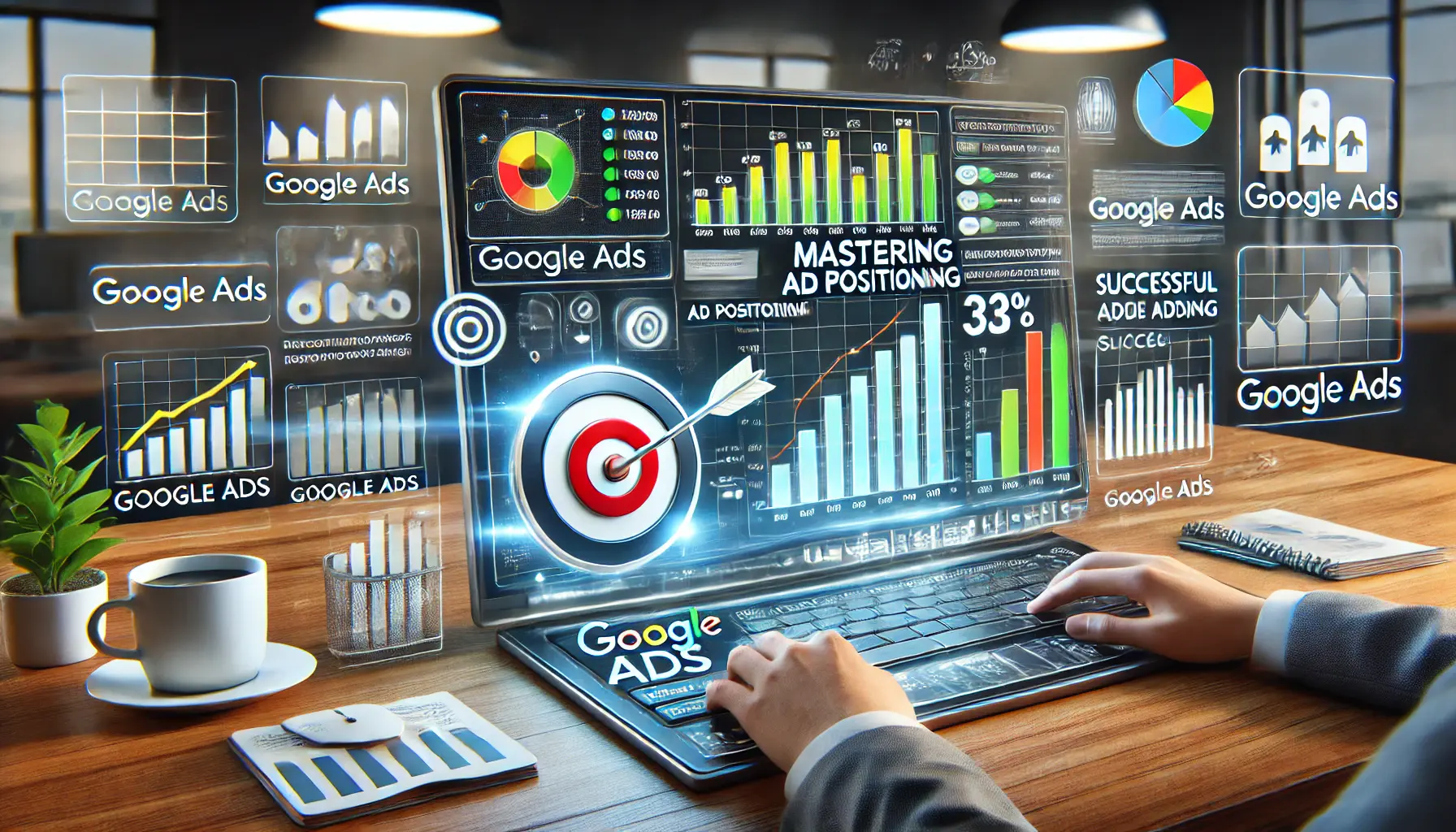
Mastering Ad Positioning for Google Ads Success
Conclusion: Mastering Ad Positioning for Google Ads Success
Ad positioning within Google Ads is instrumental in defining the performance of your ad campaigns.
While the techniques discussed above can help you improve and maintain optimal ad positioning, this requires regular optimization, strategic bidding, and refining your ads for user intent.
These are the key elements we have explored throughout this article.

Essential Takeaways for Enhancing Ad Positioning
Key Takeaways for Improving Ad Positioning
Below is a rundown of the most important strategies to focus on when optimizing your Google Ads campaigns:
- Keyword Optimization: Regularly update your keyword lists to reflect trends and improve relevance. Improve ad positioning by adding high-performing keywords and removing underperforming ones.
- Performance-Based Bid Adjustments: Adjust bids based on keyword performance. For high-performing keywords, increase bids to maintain top positions. Reducing bids on less effective terms can help optimize your budget.
- Ad Copy Optimization: Experiment with different variations of ad copy to see what works best with your target audience. Using action-oriented language, relevant keywords, and highlighting unique selling points will improve engagement and positioning.
- Balancing Quality Score and Bids: Maintaining a high bid alone will not guarantee a top ad position. Focus on improving your Quality Score by ensuring your ad copy, landing page, and keywords are relevant to the user’s search intent.
- Ad Extensions: Use ad extensions to add extra information, such as phone numbers, site links, and promotions. This will increase user engagement and improve your ad’s position on the SERP.

Continuous Monitoring and Adaptation in Google Ads
The Importance of Continuous Monitoring and Adaptation
With digital advertising being highly competitive, your ads are always influenced by external factors such as competitor bids, seasonal trends, and changes in user behavior.
Constantly analyzing ad performance metrics using tools like Google Analytics and SEMrush will allow you to make informed decisions about your campaign strategy and stay competitive.
Monitoring your competitors’ ad positioning provides insights into market opportunities.
By evaluating their keyword selections, ad copy, and positioning, you can identify gaps in your own strategy and implement necessary changes to remain competitive.
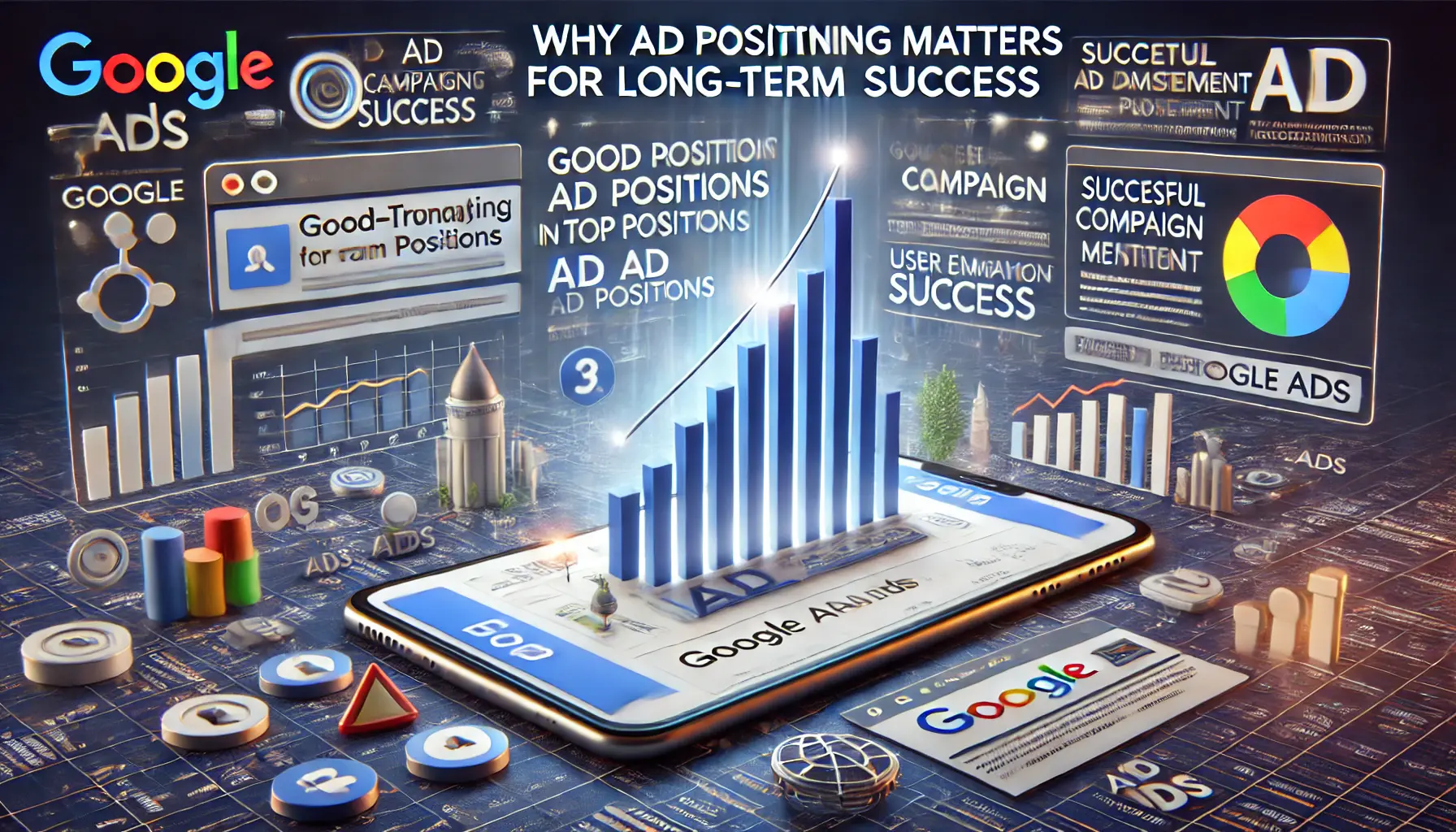
The Importance of Ad Positioning for Long-Term Success
Why Ad Positioning Matters for Long-Term Success
Mastering ad positioning on Google Ads is all about generating increased visibility, better engagement, and improved ROI.
Ads that appear at the top of the SERP are more likely to catch users’ attention, generate clicks, and drive conversions.
By implementing the strategies discussed, you can improve your ad positioning and achieve long-term success with your advertising efforts.
Following best practices and continually refining your campaigns will enable you to secure top positions on the Search Engine Results Page (SERP), resulting in better performance and a higher return on investment in the competitive world of Google Ads.

Frequently Asked Questions About Ad Positioning
Your campaigns can be managed by an agency specialized in Google Ads, check out our service page.
Frequently Asked Questions About Ad Positioning in Google Ads
Ad positioning in Google Ads comes with many questions, especially for marketers aiming to improve campaign visibility.
Below are frequently asked questions about Google Ads positioning, with concise and clear answers.
Ad position is determined by your bid, Quality Score, ad relevance, expected CTR, and the landing page experience.
By optimizing these components, you can positively impact your ad position on the SERP.
High CTR and relevant ad extensions also improve Quality Score.
A higher bid does not guarantee a top position.
Google Ads also factors in your Quality Score, ad relevance, and user experience.
Balancing your bid with a strong Quality Score improves your chances of securing a better position.
Ad extensions provide additional information, such as phone numbers or site links, making your ad more relevant and appealing to users.
Using ad extensions increases engagement and improves your ad’s overall position on the SERP.
Ad copy relevance directly impacts your Quality Score and CTR.
Ads that closely match the user’s search query are more likely to be clicked, improving your ad’s relevance and positioning on the Google Ads platform.
Google Ads offers metrics like ‘Search Top IS’ and ‘Search Absolute Top IS’ to track ad positioning.
Additionally, tools like SEMrush and Google Analytics help monitor competitor positioning and keyword performance, providing deeper insights.
It’s best to revisit your keyword list every few months or whenever trends change.
Regular updates help keep your ad competitive and improve positioning in Google Ads.
Yes, ad positioning can fluctuate frequently due to competition, bidding strategies, and seasonal trends.
Continuous monitoring and adjustments are necessary to maintain a stable ad position.
Yes, a high Quality Score can lower your CPC while improving ad positioning.
Google rewards relevant, high-quality ads with better positioning at lower costs, making it an essential factor for efficient budget management.

